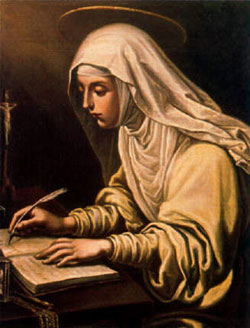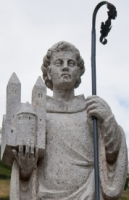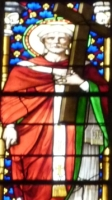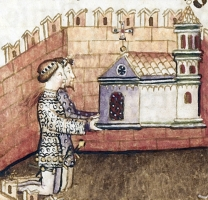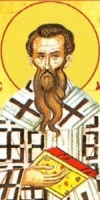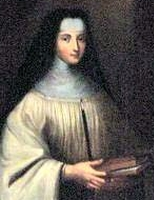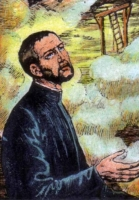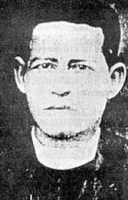St. Lezin
Feastday: February 13
Birth: 540
Death: 609
French bishop. A member of the Frankish aristocracy, he gave up worldly Concerns and entered the Church. Known for his sanctity, he later became bishop of Angers.
Licinius of Angers (also known as Saint Lezin, or Lésin) (c.540–c.610) was a Frankish nobleman and bishop of Angers, celebrated as Catholic saint on 13 February.[1]
Lucinius was born about 540 and sent to the court of King Chlothar I when about 20. Chlothar's son King Chilperic I made him governor of Angers. Upon the death of Bishop Audouin in about 600, he was also made bishop of Angers by King Chlothar II.[2]
He founded a monastery and a Church both dedicated to St John the Baptist, and was buried there. His age at death was said to be 64 and the date 618 by one source,[2] but others state earlier
Bl. Archangela Girlani
Feastday: February 13
Birth: 1460
Death: 1494
Carmelite mystic. She was born in Trino, in northern Italy, in 1460, baptized Eleanor. Though planning to become a Benedictine nun, she was thwarted in her desire by her horse - the animal refused to carry her to the convent. She then became a Carmelite in Parma, Italy, taking the name Archangela, being professed in 1478. Named prioress of the convent, Archangela founded a new Carmel in Mantua. She was gifted with ecstasies and levitation and was reported to have performed miracles. Archangela died on January 25,1494, and her cult was confirmed in 1864.
Archangela Girlani, born as Eleanora Girlani, (1460 – 25 January 1494) was an Italian Carmelite nun who was known for her visions. Pope Pius IX beatified her on 1 October 1864.
Life
Eleanora Girlani was born in 1460 to a noble family of Trino in the Duchy of Savoy. Having been educated by the Benedictines, she had planned to become a Benedictine. However, on her way to the abbey, her horse refused to take her there. Interpreting this a sign, she instead became a Carmelite nun in Parma, and was given the religious name of Archangela.[1] She made her first vows in 1478. Later she was elected the prioress of her monastery, and went on to found a new Carmelite convent in Mantua.[2]
Girlani is remembered as a mystic who had a special devotion to the Most Holy Trinity,[3] and was reported to have the gifts of ecstasies, and miracles, including levitation.[1]
Widespread devotion and reports of healing arose after her death in 1494. Her feast day is celebrated on 13 February.
St. Agabus
புனித_அகபு (முதல் நூற்றாண்டு)
பிப்ரவரி 13
அகபு அல்லது அகபாஸ் (#StAgabus) என அழைக்கப்படும் இவர், எருசலேமைச் சார்ந்தவர்.
யூதரான இவர் இயேசு அனுப்பிய எழுபத்து இரண்டு சீடர்களில் ஒருவராவார் (லூக் 10: 1-24). மேலும் இவர் இயேசுவின் இறுதி இராவுணவின்போது, அவரது பன்னிரு திருத்தூதர்களோடு மேலறையில் இருந்தவர் என்று சொல்லப்படுகிறது.
இறைவாக்கினராக அறியப்படும் இவர் உரோமையின் ஆட்சிக்குட்பட்ட பகுதியில் பெரிய பஞ்சம் ஏற்படும் என முன்னறிவித்தார். இவர் சொன்னது போன்றே கிளாதியு மன்னன் காலத்தில் பெரிய பஞ்சம் ஏற்பட்டது (திப 11: 28).
திருத்தூதர் புனித பவுலிடம் இவர், எருசேமிற்குச் சென்றால் கைது செய்வீர் என்று எச்சரித்தார் (திப 21: 10-12). இவர் சொன்னது போன்றே புனித பவுல் எருசலேமில் கைது செய்யப்பட்டார். இவ்வாறு பின்னர் நடக்கவிருப்பதை முன்கூட்டியே அறிவித்து வந்த இவர் பல இடங்களுக்கும் சென்று, நற்செய்தி அறிவித்தார்.
இதையறிந்த யூதர்கள் இவரை அடித்துத் துன்புறுத்தி, கல்லால் எறிந்து, அந்தியோக்கு நகருக்கு வெளியே இழுத்துச் சென்று கொன்று போட்டார்கள்.
Born 1st century AD
Antioch
(modern-day Antakya, Hatay, Turkey)
Died unknown
Antioch
Venerated in Roman Catholic Church
Eastern Orthodox Church
Church of England
Feast February 13 (Roman Catholic)
March 8 (Eastern Orthodox)
Patronage prophets
Martyr and one of the seventy-two disciples mentioned by St. Luke. He was a Jewish convert to the faith, noted as a prophet. Agabus predicted a famine in the Roman Empire and probably Paul's imprisonment. Agabus was unable to dissuade Paul from going to Jerusalem. The martyr died for the faith in the city of Antioch.
Agabus /ˈæɡəbəs/ (Greek: Ἄγαβος) was an early follower of Christianity mentioned in the Acts of the Apostles as a prophet. He is traditionally remembered as one of the Seventy Disciples described in Luke 10:1–24.
Biblical and traditional accounts
According to extrabiblical tradition, Agabus appears to have been a resident of Jerusalem. He is said to have been one of the seventy disciples, mentioned in the Gospel of Luke, commissioned to preach the gospel.[1] It is said that Agabus was with the twelve apostles in the upper room on the day of Pentecost.[2]
According to Acts 11:27–28, he was one of a group of prophets who travelled from Jerusalem to Antioch. The author reports that Agabus had received the gift of prophecy and predicted a severe famine, which occurred during the reign of the emperor Claudius.[3]
Also, according to Acts 21:10–12, 'a certain prophet', (Greek: τις) named Agabus met Paul the Apostle at Caesarea Maritima in AD 58. He was, according to the Jamieson-Fausset-Brown Bible Commentary, 'no doubt the same' Agabus as had been mentioned in Acts 11:27–28,[4] and Heinrich Meyer states that 'there is no reason against the assumed identity of this person with the one mentioned in Acts 11:28.[5] Agabus warned Paul of his coming capture; he bound his own hands and feet with Paul's belt to demonstrate what would happen if he continued his journey to Jerusalem, stating the message of the Holy Spirit:
So shall the Jews at Jerusalem bind the man who owns this belt, and deliver him into the hands of the Gentiles.
Paul, however, would not be persuaded to stay away.[3]
Agabus' symbolic action has been compared [6] with the Jewish prophet Jeremiah:
Thus the LORD said to me, "Go and buy yourself a linen waistband and put it around your waist, but do not put it in water." So I bought the waistband in accordance with the word of the LORD and put it around my waist ... For as a belt is bound around the waist, so I bound all the people of Israel and all the people of Judah to me,' declares the LORD, 'to be my people for my renown and praise and honor.[7]
Tradition says that Agabas went to many countries, teaching and converting many. This moved the Jews of Jerusalem to arrest him, and they tortured him by beating him severely, and putting a rope around his neck. He was dragged outside the city and stoned to death.[2] Jesuit theologian Anthony Maas says he was martyred at Antioch.[3]
Veneration
The Roman Catholic Church celebrates his feast day on February 13, while the Eastern Christianity celebrates it on March 8
St. Catherine de Ricci
தூய கேத்ரின் தே ரிச்சி
கேத்ரின், 1522 ஆம் ஆண்டு, ஏப்ரல் திங்கள் 22 ஆம் நாள், இத்தாலியில் உள்ள ப்ளாரென்ஸ் என்னும் இடத்தில் பிறந்தார். இவருடைய தந்தை வாணிபம் செய்துவந்ததால், குடும்பம் செல்வச் செழிப்பில் திளைத்தது, அதனால் அவர் எந்ததொரு குறையும் இல்லாமல் வளர்ந்துவந்தார். கேத்ரின் தன்னுடைய பள்ளிக்கல்வியை மொன்டிசெல்லி என்னும் இடத்தில் கற்றார். அங்கு இவர் கல்வி கற்கும்போதே இறைவன் அழைப்பினை உணர்ந்து, துறவற சபையில் சேர்ந்தார்.
துறவற சபையில் சேர்ந்தபின்பு கேத்ரின் இயேசுவின் பாடுகளைக் குறித்து அதிகமாக தியானித்தார். அவர் அப்படி இயேசுவின் பாடுகளைக் குறித்து தியானிக்கும்போது பலநேரங்களில் பரவச நிலையை அடைந்தார். ஒவ்வொரு வாரமும் வியாழக்கிழமை தொடங்குகின்ற இந்த தியானம் வெள்ளிக்கிழமை மதியம் வரை நீடிக்கும். இதன்மூலம் கேத்ரின் இறைவனுடைய ஆசிர்வாதத்தை சிறப்பாகப் பெற்றார். அவர் இறைவனின் ஆசிர்வாதத்தைப் பெற்றுக்கொண்ட உண்மையை அறிந்த மக்கள், ஆயர்கள், கர்தினால்கள், ஏன் திருத்தந்தையர்கள் கூட அவருடைய ஆலோசனையைக் கேட்பதற்காக வந்தார்கள். இது ஒருபுறம் நடந்துகொண்டிருந்தாலும், இன்னொருபுறம் அவருடைய சபை அருட்சகோதரிகளால் மக்களை ஏமாற்றுகின்றார், நாடகம் போடுகின்றார் என்று கேளிக்கும் கிண்டலுக்கும் உள்ளாகக்கப்பட்டார். இது கேத்ரினுக்கு மிகப் பெரிய வேதனை. அதனால் அவர் இயேசுவின் பாடுகளைக் குறித்து தியானிப்பதை நிறுத்திக்கொண்டார்.
கேத்ரின், என்னதான் இயேசுவின் பாடுகளைக் குறித்து தியானிப்பதை நிறுத்திக்கொண்டாலும் இயேசு அவரை வேறொரு விதமாய் தெரிந்துகொண்டு சிறப்பு செய்தார். ஆம், ஆண்டவராகிய இயேசு கேத்ரினுக்கு ஐந்து காய வரத்தைக் கொடுத்து, அவரை தன்னுடைய பாடுகளில் பங்குகொள்ளச் செய்தார். இதனால் கேத்ரின் மிகுந்த உடல் வேதனைக்கு உள்ளானார். ஆனாலும் ஆண்டவருடைய வேதனையில் தானும் பங்கு கொள்கின்றேன் என்பதை நினைத்து ஆறுதல் அடைந்தார். இப்படி அவருடைய ஆன்மீக வாழ்வு ஒருபக்கம் போய்க்கொண்டிருந்தாலும், இன்னொரு பக்கம் அவர், தான் இருந்த சபையில் நவ கண்ணியர்களுக்குப் பொறுப்பாளர், துணை சபைத் தலைவி, தலைவி என்று பொறுப்புகளில் உயர்ந்துகொண்டே இருந்தார். இப்படி இயேசுவின் பாடுகளில் பங்குகொண்டு, உத்தம துறவியாக வாழ்ந்து வந்த கேத்ரின் 1590 ஆம் இறையடி சேர்ந்தார். இவருக்கு 1746 ஆம் ஆண்டு திருத்தந்தை பதினான்காம் ஆசிர்வாதப்பரால் புனிதர் பட்டம் கொடுக்கப்பட்டது.
Born 23 April 1522
Florence, Republic of Florence
Died 2 February 1590 (aged 67)
Prato, Grand Duchy of Tuscany
Venerated in Roman Catholic Church
(Dominican Order)
Beatified 23 November 1732, Rome, Papal States by Pope Clement XII
Canonized 29 June 1746, Rome, Papal States by Pope Benedict XIV
Major shrine Basilica dei Santi Vincenzo e Caterina de' Ricci, Prato, Italy
Feast 2 February (changed in 1971 from 13 February)
Attributes Religious habit
Patronage The sick
St. Catherine was born in Florence in 1522. Her baptismal name was Alexandrina, but she took the name of Catherine upon entering religion. From her earliest infancy she manifested a great love of prayer, and in her sixth year, her father placed her in the convent of Monticelli in Florence, where her aunt, Louisa de Ricci, was a nun. After a brief return home, she entered the convent of the Dominican nuns at Prat in Tuscany, in her fourteenth year. While very young, she was chosen Mistress of Novices, then subprioress, and at twenty-five years of age she became perpetual prioress. The reputation of her sanctity drew to her side many illustrious personages, among whom three later sat in the chair of Peter, namely Cerveni, Alexander de Medicis, and Aldo Brandini, and afterward Marcellus II, Clement VIII, and Leo XI respectively. She corresponded with St. Philip Neri and, while still living, she appeared to him in Rome in a miraculous manner.She is famous for the "Ecstacy of the Passion" which she experienced every Thursday from noon until Friday at 4:00 p.m. for twelve years. After a long illness she passed away in 1589. Her feast day is February 13.
Catherine de' Ricci (Italian: Caterina de' Ricci) (23 April 1522 – 2 February 1590), was an Italian Dominican Tertiary sister. She is believed to have had miraculous visions and corporeal encounters with Jesus, both with the infant Jesus and with the adult Jesus.[1] She is said to have spontaneously bled with the wounds of the crucified Christ. She is venerated for her mystic visions and is honored as a saint by the Catholic Church.
Life
She was born Alessandra Lucrezia Romola de' Ricci in Florence to Pier Francesco de' Ricci, of a patrician family, and his wife, Caterina Bonza, who died soon after. At age 6 or 7, her father enrolled her in a school run by a monastery of Benedictine nuns in the Monticelli quarter of the city, near their home, where her aunt, Luisa de' Ricci, was the abbess. She was a very prayerful person from a very young age. There she developed a lifelong devotion to the Passion of Christ. After a short time outside the monastery she entered the Convent of St Vincent in Prato, Tuscany, a cloistered community of religious sisters of the Third Order of St. Dominic, disciples of the noted Dominican friar Girolamo Savonarola, who followed the strict regimen of life she desired. In May 1535 she received the religious habit from her uncle, Timoteo de' Ricci, who was confessor to the convent, and the religious name of Catherine, after the Dominican tertiary, Catherine of Siena.[2]
De' Ricci's period of novitiate was a time of trial. She would experience ecstasies during her routine, which caused her to seem asleep during community prayer services, dropping plates and food, so much so that the community began to question her competence, if not her sanity. Eventually the other Sisters became aware of the spiritual basis for her behavior. By the age of 30 she had risen to the post of prioress.
She is reported to have been a nun with visions, states Constance Classen, who miraculously held baby Jesus dressed in swaddling clothes, and was mystically married and united with adult Jesus.[1]
As the prioress, de' Ricci developed into an effective and greatly admired administrator. She was an advisor on various topics to princes, bishops and cardinals. She corresponded with three figures who were destined to become popes: Pope Marcellus II, Pope Clement VIII, and Pope Leo XI. An expert on religion, management and administration, her advice was widely sought. She gave counsel both in person and through exchanging letters. It is reported that she was extremely effective and efficient in her work, managing her priorities very well.
It is claimed that de' Ricci's meditation on the Passion of Christ was so deep that she spontaneously bled, as if scourged. She also bore the Stigmata. During times of deep prayer, like Catherine of Siena, her patron saint, a coral ring representing her marriage to Christ appeared on her finger.
It is reported that de' Ricci wore an iron chain around her neck and engaged in extreme fasting and other forms of penance and sacrifice, especially for souls in Purgatory.
One of the miracles that was documented for her canonization was her appearance many hundreds of miles away from where she was physically located in a vision to Philip Neri, a resident of Rome, with whom she had maintained a long-term correspondence. Neri, who was otherwise very reluctant to discuss miraculous events, confirmed the event.[2]
De' Ricci lived in the convent until her death in 1590 after a prolonged illness. Her remains are visible under the altar of the Minor Basilica of Santi Vicenzo e Caterina de' Ricci, Prato, which is next to the convent associated with her life.
Veneration
De' Ricci was beatified by Pope Clement XII in 1732, and canonized by Pope Benedict XIV in 1746 in a spectacular ceremony for which a magnificent ‘apparato’ was constructed.[3] In celebration of the saint's canonization, Domenico Maria Sandrini wrote an authoritative biography of the new saint.[4] Her feast day falls on 2 February.
Blessed Jordan of Saxony
சபைத்தலைவர் சாக்சன் நகர் ஜோர்டன் Jordan von Sachsen
பிறப்பு
1200,
போர்க்பெர்கே Borgberge, ஜெர்மனி
இறப்பு
13 பிப்ரவரி 1237,
சிரியா
இவர் தான் பிறந்த ஊரின் அருகிலிருந்த பாடர்போன் (Paderborn) என்ற நகரில் கல்வி பயின்றார். இவர் தன் கல்வி படிப்பை முடித்தப்பின், புனித தொமினிக்கன் துறவற சபையில் சேர்ந்து குருவானார். 1221 ஆம் ஆண்டு அச்சபைத்தலைவர் இறந்துவிடவே, அச்சபையின் இரண்டாவது சபைத்தலைவர் பொறுப்பை புனித ஜோர்டன் ஏற்றார். இவர் தன் சபையை உலகெங்கும் பரவ அயராது உழைத்து நற்செய்தியை போதித்தார். தன் சபை குருக்கள் பலரை பாரிஸ் நகரில் இருந்த கல்லூரிகளில் படிக்கவைத்தார். இவர் பல வித்தியாசமான முறைகளில் தன் சபையை வளர்த்தெடுத்தார்.
இவர் தன் உள்மனதிலிருந்து மற்றவர்களை அன்புச் செய்தார். அனைவரும் இவரை எளிதில் நெருக்கக்கூடிய அளவிற்கு சாதாரண மனிதராகத் திகழ்ந்தார். இவர் தனது அழகிய மறையுரையினால் பல இளைஞர்களின் வாழ்வில் மாற்றத்தை ஏற்படுத்தினார். இவரின் வாழ்வால் பலர் ஈர்க்கப்பட்டு இவரின் சபைக்கு வந்து சேர்ந்தனர். இவர் அச்சபையில் மிகச் சிறந்த பேராசிரியராக திகழ்ந்தார். இவர் ஏராளமான பயணங்களை மேற்கொண்டு தன் சபையைப் பரப்பினார். அவர் சிரியாவிற்கு பயணம் செய்யும்போதுதான் இறந்தார். இறந்தபிறகு இவரின் உடல் இஸ்ரயேல் நாட்டில் தொமினிக்கன் ஆலயம் ஒன்றில் அடக்கம் செய்யப்பட்டது
Also known as
• Jordan de Alamaia
• Giordana, Giordano, Giordanus, Gordanus, Jordana, Jordanka, Jordanus
Profile
Born to the Saxon nobility, he received a pious upbringing and was noted for his charity to the poor from an early age. Educated in Germany, and received his masters degree in theology at the University of Paris. Joined the Order of Preachers in 1220 under Saint Dominic himself. Prior-provincial of the Order in Lombardy, Italy in 1221. Succeeded Dominic as master-general of the Order in 1222. Under his administration, the Order spread throughout Germany, and into Denmark.
A noted and powerful preacher; one of his sermons brought Saint Albert the Great into the Order. Wrote a biography of Saint Dominic. His writings on Dominic and the early days of the Order are still considered a primary sources. Spiritual director of Blessed Diana d'Andalo, and helped her found the monastery of Saint Agnes.
Born
• c.1190 at Padberg Castle, diocese of Paderborn, Westphalia, old Saxony (in modern Germany)
• rumoured to have been born in Palestine while his parents were on a pilgrimage, and named after the River Jordan, but this is apparently aprochryphal
Died
• drowned in 1237 in a shipwreck off the coast of Syria while on a pilgrimage to the Holy Land
• buried in Acre
Beatified
1826 (cultus confirmed) by Pope Leo XII
Patronage
• against drowning
• Dominicans
• University of Santo Tomas Faculty of Engineering
Blessed Eustochium of Padua
Also known as
• Lucrezia Bellini
• Cinderella of the Cloister
Profile
Daughter of a Paduan nun who had been seduced into ignoring her vow of chastity; Lucrezia grew up in the convent. She felt a call to the religious life, which many of the sisters of opposed due to the scandal of her birth. The bishop approved of her vocation, however, and she entered her novitiate as a Benedictine nun in 1461, taking the name Eustochium.
For four years she suffered from violent, hysterical fits. She was considered to be possessed, imprisoned, fed on bread and water, periodically starved and repeatedly exorcised. When her abbess fell ill, she was accused of poisoning the woman, and had to be saved from a mob of townspeople who wanted to burn her as a demon. Between these bouts, she was gentle, pious, patient and humble, apparently seeing it all as a form of penance. Her confessor and spiritual director insisted that she be allowed to continue with her vocation, and her sanctity won over many of the sisters who had opposed her.
She died very soon after her formal vows. The name of Jesus was found cauterized on her breast. She is venerated in Padua.
Born
1444 at San Prosdocimo convent, Padua, Italy as Lucrezia Bellini
Died
13 February 1469 at San Prosdocimo convent, Padua, Italy of natural causes
Patronage
• against insanity
• against mental illness
• against temptations
• children whose parents are not married
• illegitimacy
• mentally ill people
Saint Martinian the Hermit
Also known as
Martinian of Athens
Profile
Hermit from age 18. Miracle worker. There are a couple of stories attached to Martinian; in them the line between fact and a good story probably blurs a little.
Legend says that one day a miserable, bedraggled woman named Zoe showed at his door requesting a traveller's hospitality. He took her in, but her true colors soon showed as she cleaned up and showed herself to be a beautiful woman who tried to seduce Martinian. When he realized how tempted he was, he built a fire and put his feet in it; the pain, as you might imagine, was excruciating. Martinian said, "If I cannot stand this fire, how will I tolerate the fires of Hell?" He counseled her while she treated his wounds, converted her, and she became a nun in Bethlehem.
To save himself from his own weakness, the saint moved to a large rock surrounded on all sides by the sea. There he lived on bread and water brought to him by a Christian sailor who visited three times a year. After six years living exposed on the rock, he had a visitor - a young woman who washed up on the rock after her ship had gone down at sea. Before she could speak, he gave her all his provisions, promised to send his friend the sailor to rescue her when he returned, then threw himself into the sea. He washed up on shore, and two months later had the girl rescued. He then spent the rest of his days in Athens.
Born
c.350 at Caesarea, Palestine
Died
c.398 at Athens, Greece
Representation
• dolphin
• man standing on a rock in the sea
Blessed Christina of Spoleto
Also known as
• Agostina Camozzi
• Christina Camozzi
• Christina Visconti (a mispelling that has been perpetuated in several accounts)
• Christine...
Profile
Daughter of a physician. Married to a stone cutter, but widowed very young. She became mistress to a soldier, and bore his son, but the child died as an infant. Married a second time, she was widowed when the man was killed in a fight with a jealous rival. Realizing that her life was completely out of control, she had a conversion, became an Augustinian tertiary, took the name Christina, gave herself over to Christ, and imposed severe austerities on herself as penance for her earlier ways. Lived in a number of Augustinian convents, became known as a miracle worker, and was on a pilgrimage to the Holy Sepulchre when she died.
Born
1435 at Lake Lugano, Italy as Agostina Camozzi
Died
• 13 February 1458 in Spoleto, Italy of natural causes
• buried at the Augustinian church of Saint Nicholas in Spoleto
• re-interred at the church of Saint Gregory the Great in Spoleto
Beatified
1834 by Pope Gregory XVI (cultus confirmed)
Patronage
Calvisano, Italy
Blessed James Alfred Miller
Also known as
Leo William, Santiago
Profile
Member of the Brothers of the Christian Schools (De La Salle Brothers). He taught Spanish, English and religion, and coached football at a high school in Saint Paul, Minnesota. Noted for his knowledge and skill at construction. Assigned by the Brothers to teach in Nicaragua, he taught classes, supervised the school, and supervised the construction of ten new schools; he returned to Minnesota in 1978 when it became dangerous in the region during the Sandinista Revolution. Missionary and teacher in Guatemala in 1981. Murdered by three masked men who may have been part of the Guatemalan military intelligence death squad, G-2, while standing on a ladder, repairing a wall of a school. Martyr.
Born
21 September 1944 in Stevens Point, Wisconsin
Died
13 February 1982 in Huehuetenango, Guatemala
Beatified
• 7 December 2019 by Pope Francis
• the beatification recognition was celebrated at the Sports Complex of Colegio La Salle, Huehuetenango, Guatemala with Cardinal José Luis Lacunza Maestrojuán the chief celebrant
Saint Paulus Liu Hanzuo
Also known as
Baolu
Additional Memorial
28 September as one of the Martyrs of China
Profile
Raised in a poor Christian family, Paulus worked as a shepherd in his youth, and had little education. Feeling a call to the priesthood, he entered seminary at age 24; because he had no Latin, he was allowed to study philosophy and theology in Chinese. Ordained in his early 30’s, Father Paulus served as a priest in the apostolic vicariate of Sichuan, China, and worked with the Foreign Mission Society of Paris. Because of the persecution of Christians at the time, he worked as a vegetable seller by day, ministered to covert Catholics by night. He was betrayed to the authorities by a local carpenter; he was in the middle of Mass when found, asked for permission to finish, and when it was done he turned himself over for arrest. He was imprisoned, flogged, and when he would neither pay a bribe nor renounce his faith, he was executed. Martyr.
Born
c.1778 in Lezhi, Sichuan, China
Died
strangled to death on 13 February 1818 in Chengdu, Sichuan, China
Canonized
1 October 2000 by Pope John Paul II
Blessed Angelo Tancredi
Also known as
• Angelo of Rieti
• Angelus...
Profile
Born to the nobility, Angelo became a knight. In 1223 he was in service to Cardinal Leone Brancaleone in Rome, Italy where he met Saint Francis of Assisi. He was so taken with the teachings of Francis that he gave up the military life, became one of the first spiritual students of Francis, and one of the first twelve Franciscan friars; he was the first knight to join the Order. One of the authors of the famous Legend of the Three Companions about Francis and the early days of the Franciscans, he nursed Saint Francis during his final illness, and was singing the Canticle to him when he died.
Born
• late 12th century in Rieti, Italy
• a monastery dedicated to Saint Clare of Assisi was built on the site of the house where he was born
Died
• 1258 of natural causes
• buried near the tomb of Saint Francis of Assisi in the crypt of the basilica in Assisi, Italy
Saint Castor of Karden
Also known as
Castore, Kastor
Profile
Spiritual student of Saint Maximinus of Trier. Priest, ordained by Maximinus in the mid-4th-century. Hermit at Karden in the Moselle river region where he ministered to other hermits and small religious groups, including Saint Potentinus his sons Felicius and Simplicius.
Born
4th century, possibly in the Aquitaine region of modern France
Died
• c.400 in Karden, Moselle (in modern Germany) of natural causes
• relics enshrined in the church of Paulinus in Karden in 791
• relics transferred on 11 November 836 to the church that became the Basilica of Saint Castor in Koblenz (in modern Germany by the archbishop of Trier
Patronage
Koblenz
Saint Fulcran of Lodève
Also known as
Fulcrano, Fulcranno
Profile
Pious youth who early decided on a life in the Church. Priest. Bishop of Lodève, France for 57 years, consecrated on 4 February 949. Rebuilt many churches and convents. Founded the monastery of Saint Sauveur, and several hospitals for the poor. Untiring reformer and supporter of the spiritual life of his clergy, known for his personal asceticism.
Died
• 13 February 1006 of natural causes
• buried in the cathedral of Lodève, France
• body disinterred and burned by the Huguenots in 1572; only a few particles remain
Patronage
diocese of Lodève, France
Saint Ermenilda of Ely
Also known as
Eormenhild, Ermengild, Ermenhild, Erminilda, Ermenildis, Ermenegilda
Profile
Born a princess, the daughter of King Erconbert of Kent, and Saint Sexburga of Ely. Ermenilda was a pious youth with a strong prayer life. Married to the pagan Wulfhere, King of Mercia whom she converted by setting a good example. Queen. Mother of Saint Werburga of Chester and King Coenrad of Mercia, who abdicated to become a monk in Rome, Italy. Ermenilda used her royal influence to destroy the last of Anglo-Saxon paganism. When widowed, she became a Benedictine nun at Minster-in-Sheppy abbey, which had been founded by her mother. She served as abbess there and at the abbey at Ely, England.
Died
13 February 703 of natural causes
Saint Archelaus of Oristano
Also known as
Archelao
Profile
Convert to Christianity. Priest. Imprisoned and executed during the persecutions of either Diocletian or Trajan (records vary) for his evangelization work. Martyr.
Born
Forum Traiani (modern Fordongianus), Italy
Died
• stoned to death in Forum Traiani (modern Fordongianus), Italy
• relics enshrined in the cathedral of the Archdiocese of Oristano, Sardinia, Italy
Patronage
• Oristano, Italy, archdiocese of
• Oristano, Italy, city of
Saint Fusca of Ravenna
Also known as
Fosca
Profile
Raised in a pagan family, at age 15 Fusca converted to Christianity and was baptized along with her nursemaid, Saint Maura. During the persecutions of Decius she was ordered by her family to renounce the faith; she refused. Arrested and tortured and ordered to sacrifice to idols, she refused. Martyr.
Died
stabbed to death with a sword c.250 in Ravenna, Italy
Patronage
10 Italian and 1 Croatian city
Saint Phaolô Lê Van Loc
Also known as
Paul Le-Van-Loc
Additional Memorial
24 November as one of the Martyrs of Vietnam
Profile
Priest in the apostolic vicariate of West Cochinchina (modern Vietnam). Martyred in the persecutions of emperor Tu Ðuc.
Born
c.1830 in An Nhon, Gia Ðinh, Vietnam
Died
beheaded on 13 February 1859 at the city gates of Gia Ðinh, Vietnam
Canonized
19 June 1988 by Pope John Paul II
Saints Aimo and Vermondo of Meda
Also known as
•Aimo and Vermondo Corio
• Aimonius, Antimond, Aimone
Profile
Two brothers who founded the convent of Saint Victor in Meda, Italy.
Died
c.790
Saint Peter I of Vercelli
Also known as
Petrus
Profile
Bishop of Vercelli, Italy in 978. Murdered for political reasons by the future king of Italy, Arduin of Ivrea.
Died
• 997
• interred in the cathedral of Vercelli, Italy
• when it became a focal point for anti-Arduin sentiment, the king set the cathedral on fire
Blessed Maria Alvarez Marco
Profile
Married lay woman in 15th century Spain, the mother of at least two daughters. Widowed, she joined the Secular Franciscans, and spent her remaining 22 years in pious seclusion, living with her daughters Marina and Caterina in a house near the cathedral in Albacete, Spain.
Died
• 1501 at Albacete, Spain of natural causes
• buried in the church of the Franciscan Friars Minor at Albacete
Saint Gosbert of Osnabrück
Also known as
Gaudbert, Gautbert, Gauzbert, Gotebert, Gozbert, Gosberto, Gozberto
Profile
Spiritual student of Saint Anskar. Worked as a missionary with Saint Nithard. Bishop of Osnabruck, Germany from where he supported more missionary work in Sweden.
Died
2 February 874 of natural causes
Saint Giuliana of Turin
Also known as
• Giuliana of Ivrea
• Juliana...
Profile
Lay woman who gave Christian burial to the Martyrs of Turin in 297.
Died
relics enshrined in the church of the Martyrs in Turin, Italy
Saint Modomnoc
Also known as
Dominic, Dominick, Domnoc, Domnock, Modomnock
Profile
Member of the Irish royal O'Neill clan. Monk. Spiritual student of Saint David of Wales. Beekeeper while a novice. When he returned to Ireland, a swarm of his bees followed his ship. Hermit at Tibraghny, Kilkenny, Ireland. Bishop of Ossory, Ireland.
Born
6th century Ireland
Died
c.550 of natural causes
Patronage
bees
Blessed Berengar of Assisi
Also known as
Berengario de Asís
Profile
Mercedarian preacher in the Spanish cities of Granada, Valencia and Murcia who was noted for his prison ministry. Ransomed 358 Christians who had been enslaved by Saracen invaders.
Died
Santa Maria Guardia Pratorum
Saint Gilbert of Meaux
Profile
Studied at Saint Quentin. Archdeacon and then bishop of Meaux, France in 995.
Born
Vermandois, France
Died
• 1009 at Meaux, France of natural causes
• relics enshrined in the cathedral of Meaux in 1491
• relics enshrined in the cathedral of Meaux in 1545
• relics destroyed by Huguenots in 1562
Saint Carterius of Bourges
Also known as
Carterio, Chartier
Profile
Sixth-century missionary priest in the region of Bourges, France, working from the town of Lugny, France. The village of Saint-Chartier, France is named for him, and he is mentioned in the early Bourges calendars of the saints, but we have no details of his life or work.
Saint Stephen of Rieti
Profile
Abbot at Rieti, Italy. Pope Saint Gregory the Great describes him as "rude of speech, but cultured of life". Stephen devoted himself almost wholly to prayer, and was known for his concern with the spiritual lives even of those who wronged him.
Died
c.590 of natural causes
Saint Passivus of Séez
Also known as
Passivo, Passif
Profile
7th bishop of Séez in Normandy, France, serving in the early 6th century, though the exact dates are unknown. He attended the council of Orléans in 533, 538, 541 and 549, but we know nothing else about his time and work.
Saint Marice
Profile
Martyr.
Died
relics transferred from Rome, Italy to Cannaiola di Trevi, Umbria, Italy by order of Pope Innocent X
Patronage
Cannaiola di Trevi, Umbria, Italy (declared on 13 April 1647)
Saint Guimérra of Carcassone
Also known as
Guimera
Profile
Tenth century bishop of Carcassone, Narbonne, Gaul (in modern France).
Died
c.931 in Carcassone, Narbonne, Gaul (in modern France)
Saint Huno
Also known as
Huna
Profile
Priest and Benedictine monk at Ely, England under Saint Etheldreda. After Etheldreda's death, Huno retired to a hermitage in The Fens region of England.
Died
c.690 near Chatteris, England
Saint Stephen of Lyon
Also known as
Stephanus, Stefano
Profile
Bishop of Lyon, France. Worked to convert the Arian Burgundians to orthodox Christianity.
Died
512 of natural causes
Saint Benignus of Todi
Profile
Priest in Todi, Italy. Martyred in the persecutions of Diocletian. One of the 140 saints memorialized on the colonnades in Saint Peter's Square.
Died
c.303
Saint Maura of Ravenna
Profile
Nurse to Saint Fusca of Ravenna. Martyred in the persecutions of Decius.
Died
c.250 in Ravenna, Italy
Patronage
Frisanco, Italy
Saint Julian of Lyon
Profile
Martyr.
Died
Lyon, France, date unknown
Saint Dyfnog
Profile
Venerated in Clwyd, Wales.
Born
Wales
Died
7th century
Saint Ermen
Profile
Nun, praised for her charity.
Born
Ireland



